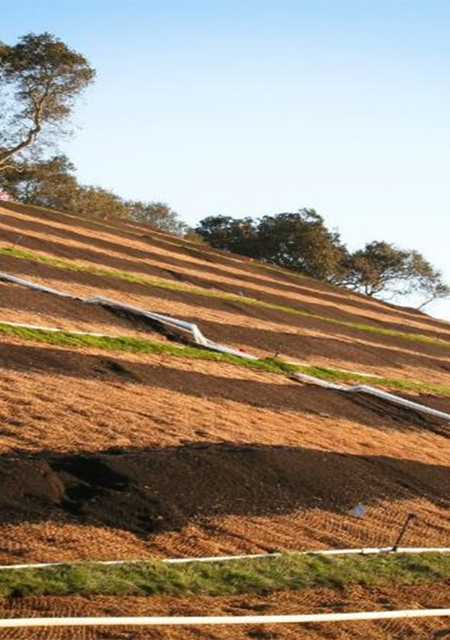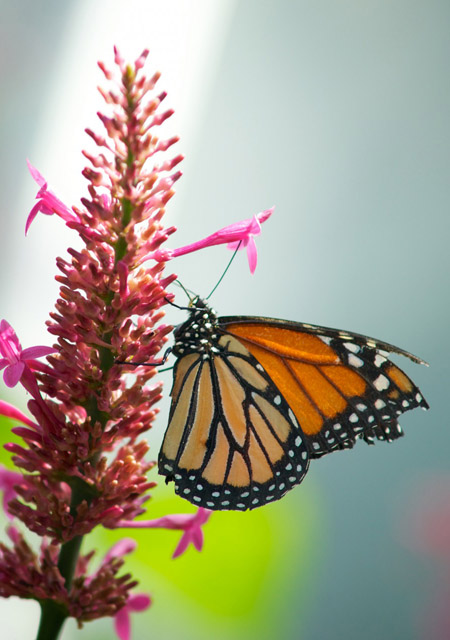HIGHWAYS CAN HELP POLLINATORS RETURN TO HEALTH
 Compost-spreading tactics to encourage native plants that both control erosion and attract pollinators / Caltrans
Compost-spreading tactics to encourage native plants that both control erosion and attract pollinators / Caltrans
In the face of rapidly-declining honeybee populations, farms across the country are under threat. In California, officials are now pioneering new methods to boost the health of the honeybees and butterflies, according to a recent Congressional hearing in Washington, D.C. To reiterate the importance of these efforts, Congressman Jeff Denham, who is also an almond farmer, said at the briefing: “making sure we have healthy pollinators is critical to a state like California.”
There to discuss these pioneering methods was Keith Robinson, ASLA, principal of the landscape architecture program at the California Department of Transportation (Caltrans). The purview of Robinson and the 240 landscape architects he leads is roadsides. Their primary job is to control erosion. But Robinson and his team have seized on that mandate to boost the health of pollinators along California’s 250,000 acres of highway roadside.
Robinson said it all starts with the soil. “We are prioritizing the improvement of soil quality on every single project. We want to make sure that soil sustains native plants and creates favorable conditions that encourage pollinator plants to not only to grow but thrive.”
Robinson’s team began this effort by performing studies on the optimal amount of compost that can be included in the soil. Compost “gets things moving along, and then the natural process takes over.” The right amount of compost allows native species to out-compete non-natives, foregoing the need for many herbicides that might negatively impact pollinators. Robinson’s team realized they could use Caltrans’ often-idle snow blowers to spread compost.
Another innovative step taken by Robinson’s team was the development of native grass sod, or pre-packaged grass carpet. “With native grass, the thinking was you can’t cut the roots and expect the plant to grow. But we’ve proved that it works.” Native grasses not only help erosion control, they encourage pollinators. “If you compare this solution to what we used to do, which was put straw down on top of compacted soil and hope for the best, you can see we’re moving down a path towards natural solutions,” Robinson said.
In addition to these steps, Caltrans ramped up planting pollinator-friendly plant species along highways. TransPLANT, an online tool, helps landscape architects choose sustainable, pollinator-friendly plants for their own projects.
Whether these effort can benefit pollinators fast enough is unknown. Robinson noted no studies have been performed on pollinator habitat health in state highway rights-of-way. And a recent study done by the Xerces Society for Invertebrate Conservation found that monarch butterfly populations in California have declined 74 percent in the past two decades.

Another speaker, Eric Silva, American Honey Producers Association, expressed resignation that reversing the trend on bee populations was a losing battle. “We’re losing half the bees over the course of the year.” The environmental culprits are relatively well-known: pesticides and chemicals, habitat loss, and pests.
Robinson offered hope for the future. His team has developed an online roadside management toolbox that helps other transportation departments learn from Caltrans’ methods. The site has tens of thousands of visitors in the U.S., but has also gotten healthy traffic from countries such as India and Canada.
And regarding the future of roadside planting, Robinson envisions hyper-local roadside ecosystems that include native as well as non-native, well-adapted species. “The pollinator and native plant advocates have voiced their appreciation for our efforts,” Robinson added. “I don’t think the public is as aware of what we are doing yet.”







Follow Us!